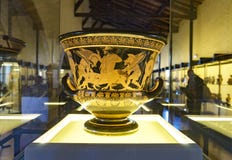

The Euphronios Krater stands 45.7 cm (18 inches) in height and has a diameter of 55.1 cm (21.7 inches). It is now in the collection of the Archaeological Museum of Cerveteri it as part of a strategy of returning stolen works of art to their place of origin. Illegally excavated from an Etruscan cemetery near Cerveteri, it was part of the collection of the Metropolitan Museum of Art in New York from 1972 to 2008, until repatriated to Italy under an agreement negotiated in February 2006.

Created around the year 515 BC, it is the only complete example of the surviving 27 vases painted by the renowned Euphronios and is considered one of the finest Ancient Greek vases in existence. The Euphronios Krater (or Sarpedon Krater) is an ancient Greek terra cotta calyx- krater, a bowl used for mixing wine with water. See more pictures of disputed antiquities.Front side depicting Sarpedon’s body carried by Hypnos and Thanatos (Sleep and Death), while Hermes watches And while any cloud of suspicion over the krater's provenance was unbeknownst to Met curators in 1972, the museum faced calls from Italy to return the artifact, originally discovered outside Rome.Ĭurrent Status: After several years of negotiation, the Met returned the krater to Italy in 2008 in exchange for the rights to display several comparable artifacts on loan. It had been purchased, however, from Robert Hecht, now on trial in Italy on charges of conspiring to deal in looted antiquities. The Metropolitan Museum of Art acquired the 2500-year-old krater an ornate bowl used to combine water with wine for $1 million in 1972, thrilled to find one of the few known examples of the ancient painter Euphronios.

Consider the case of the Euphronios krater. 05, 2009 Euphronios KraterĮven with the best of intentions, it may be difficult for museums to completely avoid the acquisition of ill-gotten artifacts.


 0 kommentar(er)
0 kommentar(er)
